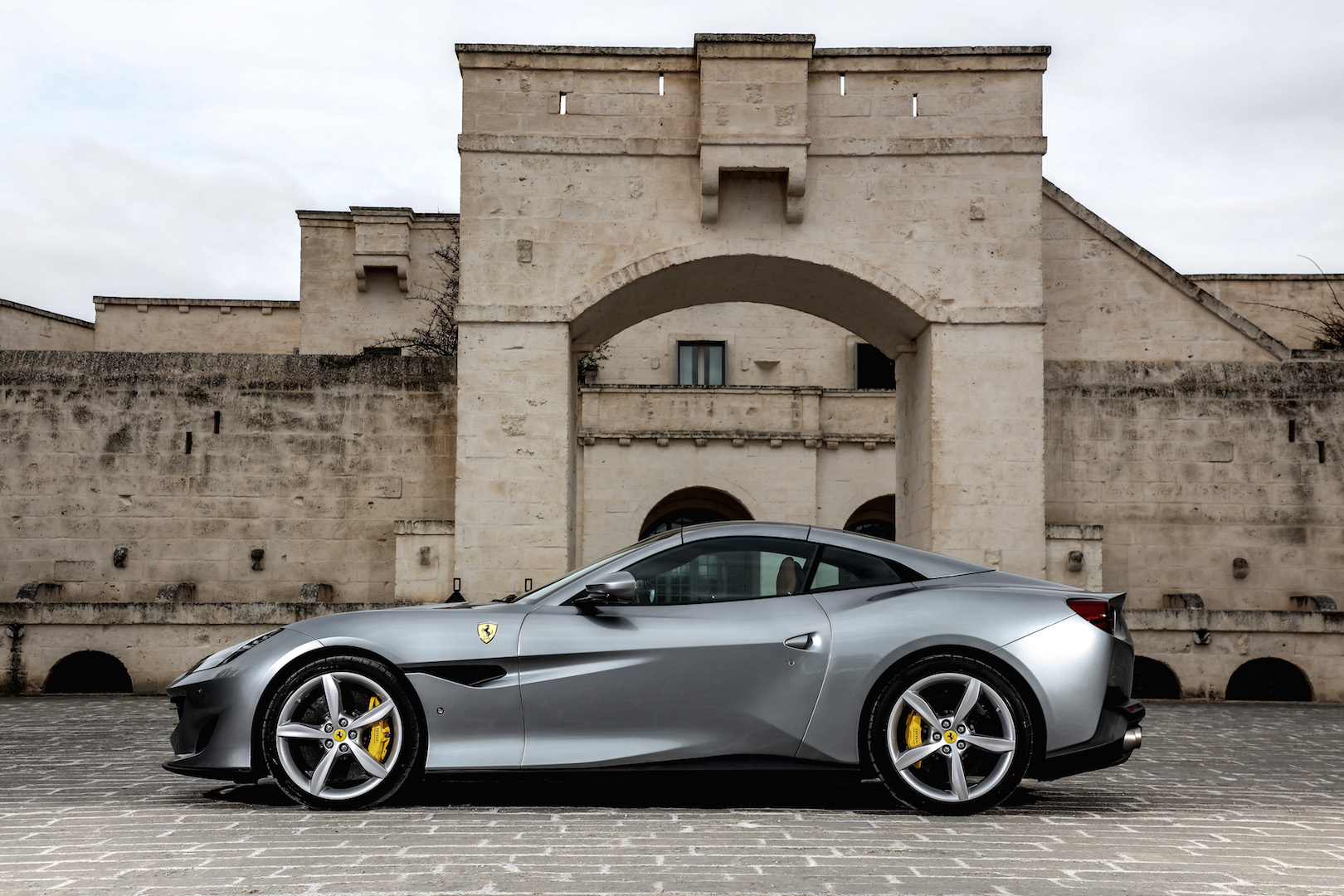Can you reasonably call a $214,543 car “entry-level”? Sure, when the factory price of the superhypercar LaFerrari was $1.35 million (and when, these days, LaFerraris commonly sell for north of $4 million at auctions). But a sticker price like that, which is the least you’re going to pay for a brand new front-engine Ferrari Portofino, forces you to judge it on the merits of bang for the buck, and not how it stacks up against other Ferraris.
The Ferrari Portofino is the replacement for the Ferrari California T, and it is—in every way—more sports car: It is costlier, lighter, stiffer, and faster, with a completely refashioned skin that comes off as more aggressive than its predecessor. The finished product—while still a front-engine, 2+2 configuration with a retractable hardtop roof and that blistering 3.9-liter twin-turbo V8—is a much more intense machine than the very user-friendly California and California T. If this is an entry-level car, we’re pleased to begin on the bottom floor.
I drove the Ferrari Portofino in the hills of southeastern Italy, about 400 miles as the crow flies from the Ferrari factory in Maranello and even further from the swank harbor town of Portofino, on the western coast. It was a gnarly week of wet spring weather, rain spitting onto green, pitted asphalt that was slippery even after the sun peeked through the clouds and kissed the ground with just a touch of warmth.

The chill in the air (and the tires) made for treacherous driving in a car that kicks out 600 horsepower at 7,500 RPMs. At every point on the power band the throttle is lively-to-twitchy, which is part of the playful dual nature character of this car: in the tradition of a Ferrari, it wants to be driven with purpose; in the tradition of the grand tourer, it rides exceptionally well (which is to say, would daily drive). Sadly, the treacherous conditions meant there was rarely enough mechanical grip in the purpose-crafted Pirellis to fully test the performance at speed.
In the morning, the rain was hitting the streets in sheets, so I pulled up to a cafe in a village outside Bari to sip an espresso and admire the look of the thing: It’s just a little lower (0.1 inches), a little wider (1.1″), and a touch longer (0.7″) than the California, but the styling is leagues more savage, sinister, and elegant. The grille, which was subdued on the Cali, has been revised into something like a lascivious leer—closer in spirit to the sexy F12 than the California.
The side panels have aggressive lines that trail the front wheel-wells and trace above and below the back tires, framing a rear haunch that hides the bulk while accentuating the athleticism. The design of the Portofino is fast, clean, and completely in control—like any great Ferrari should be. The retractable hardtop roof, made in part with magnesium to save on weight, folds into the trunk in a few seconds at any speed under 25 mph.
And the details of the design aren’t ornamental—which is to say they’re far from entry-level. Vertical slats on the outside of each headlight let air slip into the front wheel wells to force pressure out from the wheel spokes and reduce drag. The addition of two intakes cut into the bumper force air flow into both of the turbo intercoolers, and vents carved into the hood push heat out of the engine compartment.
All of these design tweaks add up to 6% less drag than the California. And that’s just part of why the Portofino is faster than the California T. They both have the same V8, with the same seven-speed whip-crack F1 dual-clutch automatic transmission. New on this RWD Portofino is a clutched “E-Diff” differential, which sends power to the rear tire with the most traction.

About that engine: It’s the same beating heart that was in the California T: a raging, 3.9-liter twin-turbo-charged V8. This is one of the last of the flat-plane crank V8s (Mustang still deploys one to great effect in the GT350), and we have nothing but love for what it does to us: it brings sophisticated volume, a rageful noise that inspires affection. It sounds like a car geek’s version of an Italian symphony and combined with the styling on the Portofino, the engine separates the Ferrari—even an entry level version—from the rest of the sports car world.

The power the reaches the wheels is so intense that you have no sense of turbo lag. The very notion of delay is laughable. But to cover their bases, the engineers at Ferrari have introduced Variable Boost Management software that limits torque in the first three gears, then boosts it in 4 through 6. In seventh gear, the boost is maxed out. It is a system that strives for and achieves complete efficiency of power delivery.
That’s what I love about Ferrari. To this day, it’s still a relatively small shop, and yet it redirects nearly 30% of its revenue (that’s EBIDTA) to research and development, and they take that money and they dream the nicest dreams. It’s easy to think of yourself as a Ferrari hater. Even the publicity material that Ferrari presented before I drove the car included a sheepish apologia that the brand struggles with “social acceptability.” That’s maketingspeak for “some people think Ferrari owners are assholes.” But, as always happens, just when I want to root against this monolithic, self-mythologizing marque, I drive one. And then I understand the myth, and I buy into it, and I bow down to it. The Portofino is fantastic—a bargain, even at $216k.




